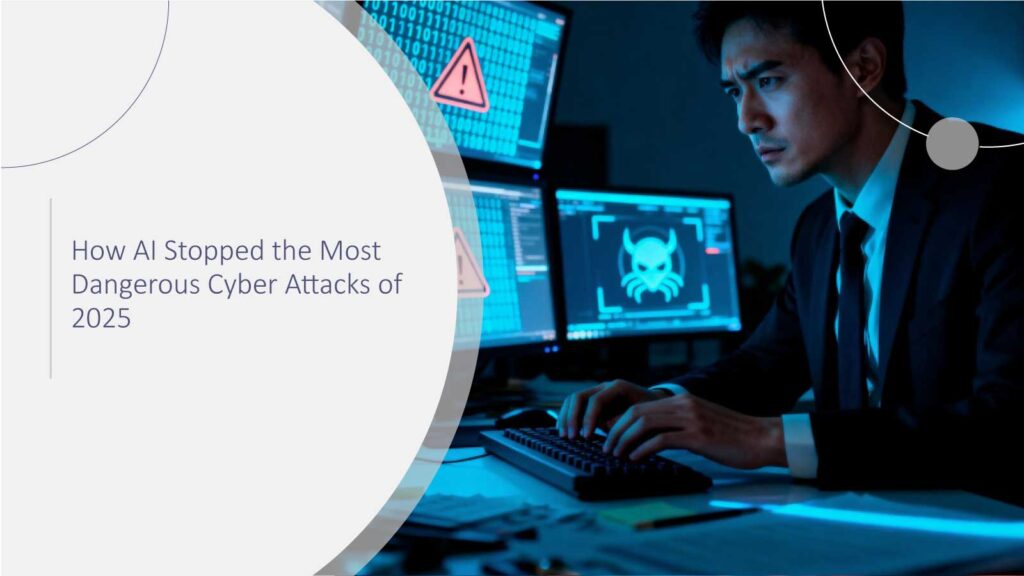2025 saw cyber threats escalating to a whole new level, that is unheard of before. The attackers used AI, deepfakes, and real-time automation to launch highly sophisticated attacks. What is interesting is that AI-powered cybersecurity tools were not just helpful and supportive but were, in fact, the main agents that stopped some of the most perilous assaults of the year. The change in the role of AI to be a frontline defender and not only a tool used for monitoring is the most important thing that this technological evolution conveys to professionals, tech enthusiasts, and busy leaders. A Gartner survey found 85% of CEOs view cybersecurity as critical to business growth – largely because of AI’s rising role.
The New Threat Landscape
Hackers in 2025 were very quick, intelligent, and they made necessary adjustments to their methods with ease. AI-based malware could update itself instantaneously, impersonate executives via deepfake calls, and accurately target critical infrastructure. The Data Security Council of India reported that AI-enabled attacks became exponentially more advanced, and thus it became imperative for the defenders to abandon the old ways of security management. By 2027, AI agents will reduce the time it takes to exploit account exposures by 50%.
Just imagine the scenario of a medium-sized financial company getting an urgent Zoom call, in which a deepfake voice is instructing a massive transfer of funds. Without AI intervention, this could have ended up in millions of losses. However, their AI platform scrutinized the voiceprint and the transaction pattern within a few seconds, and it also detected the irregularities, thus it put the transaction on hold for human verification – smartly averting the attack.
How AI Stopped Attacks
AI turned cybersecurity to a new level by playing three different roles in 2025:
1. Automated Threat Detection & Containment
AI solutions are always on the lookout for suspicious activities in networks, user operations, and endpoints. In one instance, AI detected unusual device scanning activity and automatically isolated the affected endpoint This resulted in human analysts being free to solve critical cases instead of getting overwhelmed with thousands of trivial incident reports. McKinsey found that organizations using AI-based monitoring cut incident response times by over 60%.
2. Pre-exploit Vulnerability Identification
AI systems can identify vulnerabilities before attackers exploit them. The year 2025 saw AI moles uncovering extreme-risk hacks in the open room, allowing firms to fix their systems before the threat actors took off. Transitioning from reactive to pre-emptive security is tantamount to gaining a tactical upper hand in cybersecurity. 45 % of organisations with high AI maturity keep AI projects operational for three years or more, compared to 20 % in low‑maturity organisations.
3. Adaptive Response with Human Oversight
AI augments rather than replaces security teams. AI achieves this by helping security teams in making decisions when it comes to the alerts, and thus by providing the framework for action. One SOC manager said that their team was able to decipher 36 billion events every day, thus boiling it down to only 133 occurrences, and human intervention was necessary in just eight of those cases.
Key Lessons for Professionals
An AI defense is a must: As attackers use AI, defenders should also use it to keep up with the game.
The speed and the context are of great importance: Reaction and detection within a few seconds is what can hinder the growth of a situation.
Humans are still very important: AI supports human decisions; however, control is still very much needed.
Focus on data and its management: Clean, precise data and good management are what AI is dependent on.
Never stop improving: The cybersecurity competition will never come to an end; however, AI is on the side of the defenders.
Practical Steps for Busy Professionals
Use AI to protect your most valuable assets first: Anomaly detection and phishing prevention are good areas to start from, and with few resources.
Keep an eye on explainability: It should be very clear to an analyst why the AI took a particular decision.
Work on data hygiene: Data must be reliable for AI to be effective.
Educate your employees on AI-related issues: Get your staff ready for AI-driven social engineering attacks.
Work together across departments: Besides the security department, also IT and business units should cooperate.
Keep an eye on your framework regularly: If your AI system is up-to-date with current cyber threats, it will be more efficient in defending you.
Conclusion
The year 2025 made it clear that AI is not something that can be done without in cybersecurity, rather it’s a must. Machines, along with their speed and adaptiveness, were not able to stop the dangerous attacks, but the combination with human judgment was the most powerful one. People and companies going along this human-plus-AI path have a better chance to protect their assets, trustworthiness, and work against the increasing complexity of the digital world.
FAQs
Q1: In what ways can AI identify threats that traditional systems cannot?
AI essentially looks for irregularities in the behavior of the users, the activities of the devices, and the flow of the network. Thereby, it can identify threats that have no signatures known so far.
Q2: Will AI replace the role of human security analysts?
Definitely not. The role of the human supervisor is very much needed to confirm the alerts and to make the decisions that are more subtle in nature.
Q3: Are there opportunities for small businesses to utilize AI defense?
Certainly. Even if only a few targeted AI solutions, such as phishing detection or endpoint monitoring, are implemented, significant protection can be achieved.
Q4: What cybersecurity risks arise from the use of AI?
Some of the risks are the bias of the model, poor quality of the data, and adversarial attacks, thus the need for governance and control.
Q5: What features in AI cybersecurity solutions should organizations value the most?
Organizations should first of all seek explainability, then real-time response, integration capabilities, support for data governance, and vendor effectiveness, as demonstrated in other organizations.
Don’t let cyber attacks catch you off guard – discover expert analysis and real-world CyberTech strategies at CyberTechnology Insights.
To participate in upcoming interviews, please reach out to our CyberTech Media Room at sudipto@intentamplify.com.



